User: | Open Learning Faculty Member:
Shannon Myles
February 3rd, 2020
During my data collection in the field, the systematic sampling strategy proved to be efficient at surveying the area. The few difficulties I encountered during the sampling did not damage the quality of my data in any way. First, the determination of transects was simple, but keeping that transect straight as I collected my subsamples across the field seemed to be a challenge. For the last three transects, I established three or four checkpoints along each transects in order to keep me straight. Having closer targets greatly improved the quality of my transects. Secondly, making my way along a transect turned out to be slightly more challenging than I expected. The vegetation got pretty dense in some portions of the field. I always managed to make my way through it but I had to push through some plants and small shrubs. Applying the quadrat down never was an issue. I would simply drop it over the vegetation of the area, however tall or dense that was.
The data was not surprising to me. These first samples even seem to play in favour of my initial hypothesis – more flowers appeared as I sampled away from the beach. One noticeable aspect of my data was that all types of flowers seemed to be displayed in clusters.
I think that my systematic approach to survey the site was the best option. The data collection was performed with minimal difficulties that were all overcame to maintain the essence of the systematic method. It eliminates the possibility of bias, and more samples will only add to the reliability of my data.

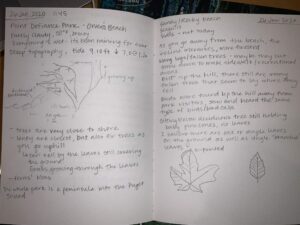
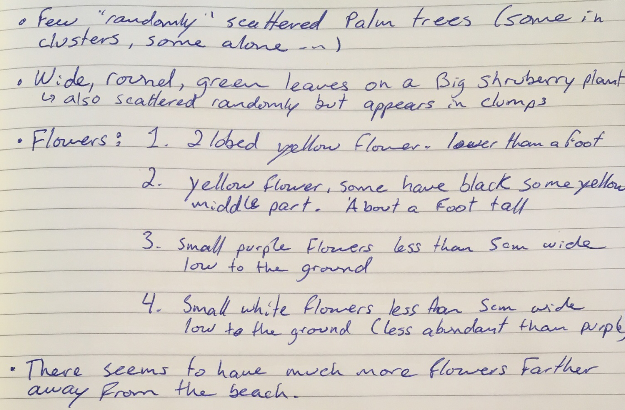
 The vegetation in the area seems to be poorly diverse with only a few different grass types, flowering plants and palm trees. The palm trees are scattered in what seems to be a random pattern throughout the area. The site also has Sea Grapes, a type of shrub with large round green leaves. As for the flowering plants, four different varieties were observed in the field. Two yellow flower kinds, one very small white flower, and another small purple flower kind were seen at the site.
The vegetation in the area seems to be poorly diverse with only a few different grass types, flowering plants and palm trees. The palm trees are scattered in what seems to be a random pattern throughout the area. The site also has Sea Grapes, a type of shrub with large round green leaves. As for the flowering plants, four different varieties were observed in the field. Two yellow flower kinds, one very small white flower, and another small purple flower kind were seen at the site.
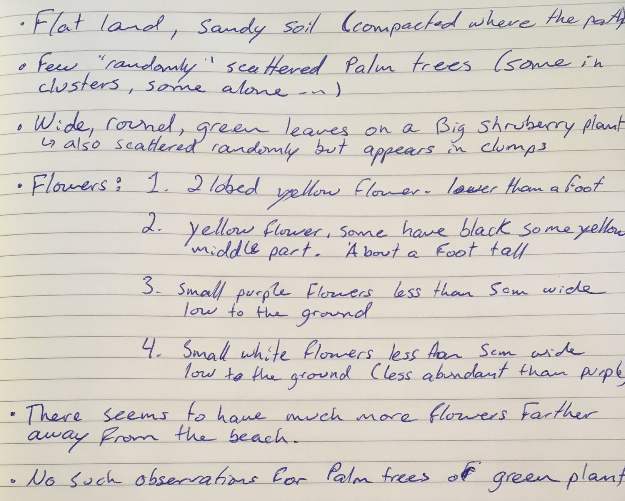

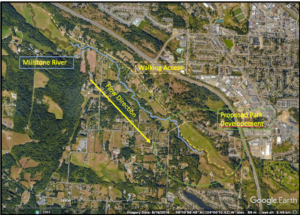 A proposal has gone through Nanaimo’s City Council to designate the area highlighted green in figure 1 as a Wetland Park. Because of the reasonably shallow gradient of the landscape, the river tends to meander and create flooding within the park when the river is high, which attracts birds and other biota.
A proposal has gone through Nanaimo’s City Council to designate the area highlighted green in figure 1 as a Wetland Park. Because of the reasonably shallow gradient of the landscape, the river tends to meander and create flooding within the park when the river is high, which attracts birds and other biota.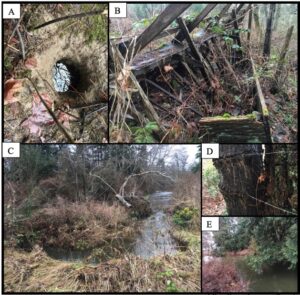 I accessed the river along the proposed park path and noticed that the large field in the park was partly flooded due to high river water. Walking down to the river, I saw that the river banks were nearly breaching, and large scale erosion was occurring along meanders (picture C). I could tell that at one point, agriculture had happened due to remnant barbed wire cutting through mature Douglas fir trees (picture D). Cow feed stalls in an advanced stage of decay were recognized, which could allude to the type of small scale farming that occurred. Invasive species that include English Holly, Himalayan Blackberry, and Scotch Broom are observed along the course of the river. Native species include numerous shrubs in hibernation, mature Douglas Firs, Maples, and alders. A possible beaver tunnel was the only signs of mammals at the site.
I accessed the river along the proposed park path and noticed that the large field in the park was partly flooded due to high river water. Walking down to the river, I saw that the river banks were nearly breaching, and large scale erosion was occurring along meanders (picture C). I could tell that at one point, agriculture had happened due to remnant barbed wire cutting through mature Douglas fir trees (picture D). Cow feed stalls in an advanced stage of decay were recognized, which could allude to the type of small scale farming that occurred. Invasive species that include English Holly, Himalayan Blackberry, and Scotch Broom are observed along the course of the river. Native species include numerous shrubs in hibernation, mature Douglas Firs, Maples, and alders. A possible beaver tunnel was the only signs of mammals at the site.